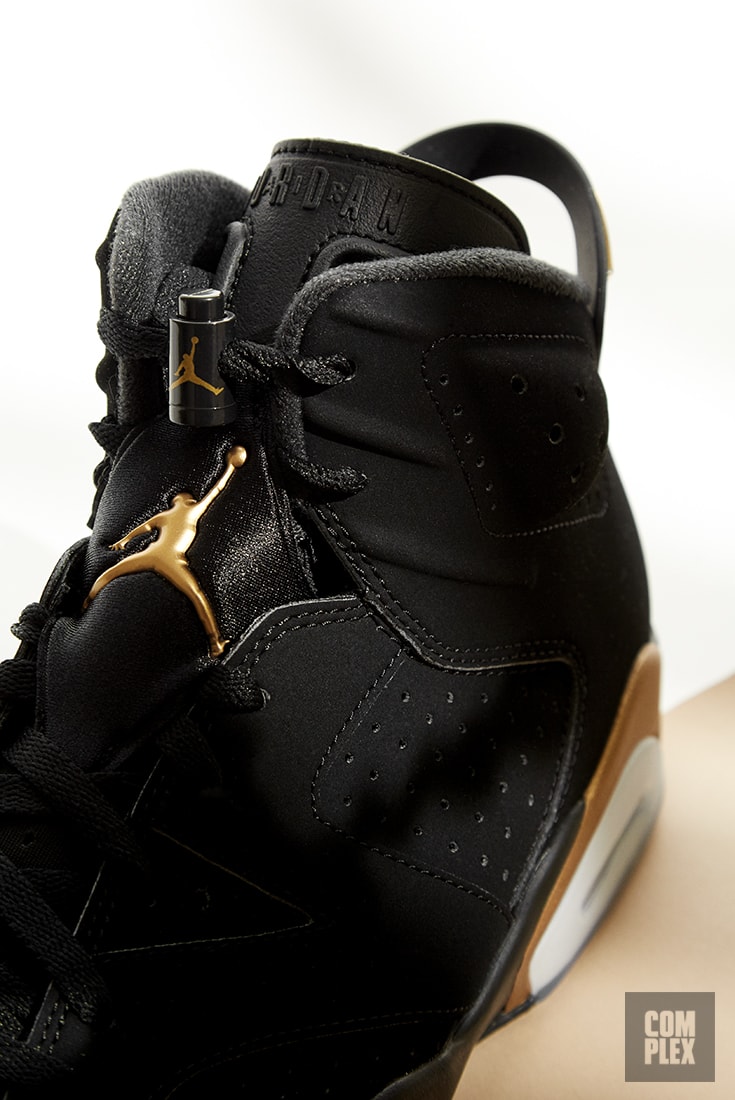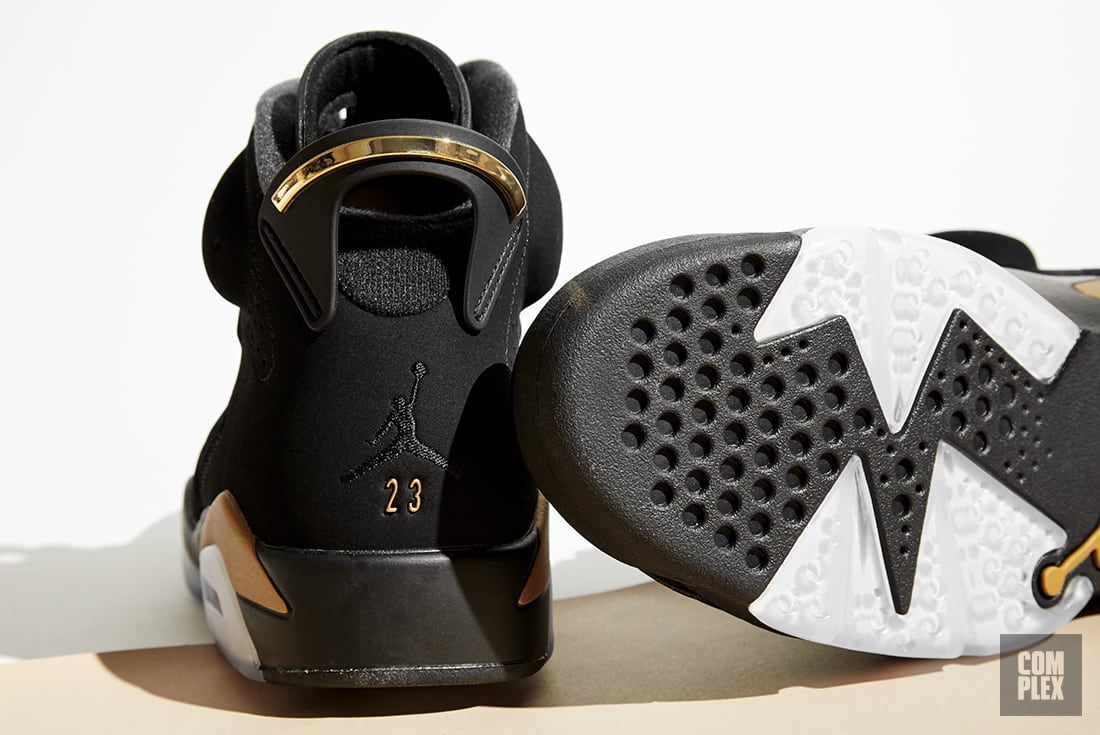How Nike’s Air Jordan DMP Defined Sneaker Culture
Written by SOURCE on April 17, 2020
In 2006, your brick Nokia might have been good for a game of Snake, but it wasn’t the golden ticket to getting a pair of shoes (or two). In the advent of the aftermarket, the influx of Instagram, and the paranoia of a pandemic, digital devices are unequivocally the go-to place to buy, share, sell, and see shoes. Roughly a decade and a half ago, things were much different. If you wanted the shoes, you had to be there.
In 2006, the shoes were the Air Jordan 6/11 Defining Moments Package, the first two-pair package from Jordan Brand and still among the most elusive sneaker releases of this century. The box set featured updated, gold-accented versions of the Air Jordan VI and the Air Jordan XI, with the regal color splashes signifying the championships Michael Jordan won while wearing those respective models. One half of the pack, the black and gold Air Jordan VI, will return for the first time in retro form on April 18.
When they originally released, copping the DMPs was a rite of passage, a figurative championship for the most dedicated sneakerheads. Before algorithms of affluence put you to the front of the digital line, being a regular at your city spot was a must with these, and it wasn’t even a guarantee at that.
“The DMPs in 2006 was the equivalent to a Travis Scott release now,” says Derek Curry, who owns boutique chain Sneaker Politics. “It was huge. It was the perfect recipe of a fucking huge hype release.”
The Defining Moments Package saw Jordan Brand telling an old story, but like never before. Cornering collectors who adored Mike’s line and Mike’s game, the dual-drop paid tribute to actual accomplishments achieved by the GOAT while updating celebrated originals. The DMPs sold storytelling and craftsmanship, much like the “Shattered Backboard” 1s a decade later. Archival inspiration connected consumers to new product, and that translated to tremendous buzz.
Or maybe, just maybe, it was because the Defining Moments Package offered another shot at the most iconic Jordan sneaker ever. In many ways, the original Air Jordan XI “Concord” from October 1995 was the first shoe that legitimately caused lineups and sold out immediately upon release.
Historically, fans first saw the new Jordans at All-Star Weekend followed by a retail release that same month. The “Concord” XIs were much different. With everyone but Tinker Hatfield assuming the Air Jordan line would be done at X, Mike came out of retirement, went rogue on Nike, and debuted the XI in May of ’95 in the NBA Playoffs. Far from ready for retail, fans had to wait a torturous five months before the “Concords” hit stores. That wait, plus Nike’s rush to produce a shoe they never thought would actually happen, created one of the first gargantuan gaps between supply and demand in Air Jordan history.
This frenzy was a first, but not a one-off, as it would happen time and time again with the “Concord” XIs for decades to come. Following another frenzy in 2000, the XIs returned revamped via the Defining Moments Package on Jan. 28, 2006.
Adding more weight to the heaviest hitter in Air Jordan history, the Defining Moments Package was a test by all assumptions. Coming out a cold month after Christmas and weeks before NBA All-Star Weekend in Houston, legend has it Jordan Brand’s first ever two-shoe package was originally supposed to release in November 2005.
In many ways, it would have made perfect sense. It would have kept the five-year cadence “Concord” customers were accustomed to and potentially blown the doors off Black Friday. But that didn’t happen. Per legend, the first-ever Jordan package was delayed due to the gold “J-O-R-D-A-N” tagging on the 11 eyelets not staying glued on. This detail was forgone on the majority of production pairs, with only a handful of eyelet oddities making it to market.
Veteran collector Simon Tan, who goes by @Depeche23Mode on Instagram, remembers gold-eyelet Jordans XIs going for up to $1,100 alone, sans the accompanying Jordan 6.
“The real die-hard sneaker collectors back then paid,” Tan says. “I did.”
While dropping a grand on grails might be commonplace in 2020, it wasn’t in 2006. Sneaker culture in the mid-2000s was the polar opposite of what it is now in regard to who, how, where, and even why shoes were purchased. Fittingly, the Defining Moments Package defined this. Hardly online and far from phones, the DMPs were allocated mostly to big-box retailers in major cities. Despite dropping at large accounts, they were almost impossible to get.
“When we got Jordans back then at Finish Line in Louisiana, we’d get 18 pairs and that was it,” says Curry, who used to work at the sneaker retail chain. “If I would get that now? I would get stabbed, straight up stabbed. They were so limited.”
In 2006, a pair of retro Jordans would usually sell out at the mall over the course of two days—never two hours. The DMPs were another beast. NikeTalk members from Long Island to San Diego would later recall the 2006 DMP launch as the “craziest release” they’d ever been to and “the biggest nightmare of all time.”
“It was like the zombie apocalypse,” says Curry, who was in the malls of Louisiana when it all went down. “Kids came barreling in pushing, tripping, running, and banging on the gates at the store. There was no hype like this.”
On the East Coast, reports recall shoes stolen from paying customers in the parking lot or even later lifted from personal apartments. On the West Coast, limited allocations rendered the package unattainable. Only 60 sets were shipped to San Diego—a city with well over 1 million residents.
Curry was in the eye of the storm for the DMPs. Thankfully, he was far craftier than the common camper.
“I drove to Baton Rouge, which is an hour away. When I pulled up there was a line around the building and I thought it was a bust,” he says. “When I checked out the line the campers told me they were only letting employees in. I had my old Finish Line uniform in the car, so I put it on and they let me walk right in. I get in before the crowd so there’s no one in the mall except me. I take my Finish Line shirt off, walk up to the first store in a white tee and they let me buy a pair. I walk up to the second store and they do the same.”
Sensing he was on to something, he offered the spooked store staff a proposition.
“I told the store employees it was crazy out there, and they were nervous to open. I offered to buy all the DMPs the store had and slip them an extra $200 so they didn’t have to open up and deal with the madness. They agreed at two stores and told me to pull up out back and they’d give me the pairs. I filled up my car in Baton Rouge and I ended up with about 30 packages.”
In many ways, the hype around the DMPs caused campout culture and bigger budgeting for Jordans, similar to what the “Galaxys” did for Foamposites in the 2010s. Why? The resale rates were absolutely crazy. Curry remembers Deon Point, current creative director at global sneaker boutique Concepts, offering him $800 for the DMP Jordans when they first released.
“I thought he was joking,” Curry says. “I had already sold some for $500 and I thought I was killing it. Back then, $800 for a pair of shoes was insane, and they were going for $1,000 on eBay. It was the most money I’d ever made off shoes”
Retailing for a then-steep $295 USD, the DMPs instantly flipped on eBay one-day auctions for upwards of $1,200—the same Saturday they hit stores.
“I can’t think of any shoe that era that would go for $1,000,” notes Curry. “It took three years for a shoe to catch that much buzz and that much hype.”
That shoe? The Nike Air Yeezy 1.
In years to follow, DMP sets often changed hands, but were rarely worn. Dropping in the dawn of deadstock, collectors lucky enough to cop the DMPs were often too scared to wear them. For years to come, the DMP XIs were far and away the most valuable retro Jordan not exclusive Jordan Brand athletes, Undefeated employees, or friends and family of Marshall Mathers. The icy soles and white mesh made them fragile to rock at events, while the gold Jumpman and absurd aftermarket value made them dangerous to wear on the streets.
Over the course of the 2010s, a lot changed in sneaker culture. The “Concords” came back, with releases proving scarily chaotic the first time and, thankfully, much safer the second. Hip-hop style shifted dramatically in that era, causing the VIs to be a late bloomer as a grail-status shoe for rappers rocking black leather skinnies and golden Versace blouses.
With the solo return of the “DMP” Air Jordan VI upon us and all the aging that’s affected the XIs, resale rates remain right around $1,000 for the original Defining Moments Package.
To those of that era, no aftermarket index can reflect the value of the original Defining Moments Package. At that time, the release was a trophy for even the most battle-tested sneakerheads. In effect, their dedication blew the door open for the rest of us. While modern technology made getting grails easier than ever, you had to be in the trenches to get the original DMPs and, frankly, most of us weren’t.






